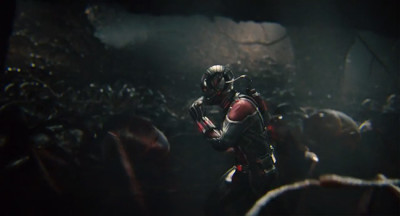How many of you had ant farms when you were growing up? For many, watching those ants burrow and dig and create those little tunnels would provide hours of fascination. And even if you didn’t have an ant farm, how fun was it to just stare at ants outside on the ground and watch them carry little pieces of grass or crumbs, marching one by one and two by two until the job was done? For the budding scientist within, these were some of the joys of childhood. And talking with director Peyton Reed, those joys stayed with him and became the catalyst for his research into creating “Ant-Man.”
So where does one start when bringing a character and movie like “Ant-Man” to life? Easy. Hit the library and start with the authority on ants, Edward O. Wilson. With about a dozen scientific books on ants to his credit plus some fiction work, Wilson is referred to by Reed as “the ant guy.” “There’s a definitive ant textbook that’s written by this guy. . .But it talks about all the specific types of ants there are in the world; and there are thousands of them [more than 12,000]. And also, their specific skill sets.” But with 12,000 ants, how does one choose?
One of the things Peyton Reed loves about “Ant-Man” is that “we introduce at least four of these specific types of ants”, the decision for which ones predicated upon the film being essentially a heist movie. In a typical heist movie, you would have “the guys doing this and this and this. But here are the ants that are doing this, here are the ants that are doing that. I guarantee that that’s something you’ve never seen in a movie before.” And to do “this and that”, the four ant types are very specific and relatively scientifically correct in their on-screen tasks:
“Crazy Ants” – Paratrechina longicornis. Known for shorting out electric systems in the southeastern United States, Crazy Ants eat electrical wires and are “crazy fast.” Taking a bit of filmmaking license, in “Ant-Man”, they are able to produce and conduct EM power. A little stretch from reality, but not too much.
“Bullet Ants” – Paraponera clavata. Known for delivering the most painful sting in the world on the Schmitt Pain Index, the pain we see inflicted by them on screen is real.
“Carpenter Ants” – Camponotus pennsylvanicus. Used in the film for ground and air transport, including one beloved Carpenter Ant named “Anttony” stealing the show, in real life, Carpenters do carry leaves, crumbs, dirt, debris, etc. but wings only take shape when they are sent out from their own colony to establish new colonies.
“Fire Ants” – Solenopsis mandibularis. Known for not only their fiery sting, Fire Ants are able to survive extreme conditions and cold and are also prone to nesting near fresh water like ponds, rivers and freshly watered lawn. Describing them as “the architects”, Reed accurately incorporates the traits of the Fire Ants by building rafts with their bodies to serve as bridges and to move through plumbing.
Once Reed and his team selected the specific genus and species of ants for film, it came time to create an ant-sized world and for Reed it was all about photorealism. “The drum I kept banging was that you can’t have a movie where you’re in the normal world that’s realistic and when you go down it feels like an animated movie. It had to feel photorealistic.”
Calling on the talents of effects supervisor Jay Morrison, “[W]e spent a lot of time together and we talked about how we were going to achieve it and how we were going to shoot it, what lenses we used, what does the world look and sound like when you’re down there. When you see dust particles floating around, how does the light play?. . . And that applied to the ants, too. That was really one of the challenges; ants that looked photoreal and also giving them some real character – especially in the case of Anttony.” Keen on staying true to some specific elements of the comic, emotional texture had to be implemented with the photorealism and science. Incorporating a Roy Rogers/Trigger, Lone Ranger/Silver relationship for Ant-Man and his Carpenter Ant buddy, Anttony, was key. “One of the iconic images [of the comic] was Ant-Man flying around on an ant. I wanted to embrace that. I was thrilled with what we did with digital effects.”
But at the end of it all, unbridled childhood glee takes hold of Peyton Reed. “The kid in me was like, ‘Aw, I can go on the Internet and look at these ants and this is actually real!’.”












